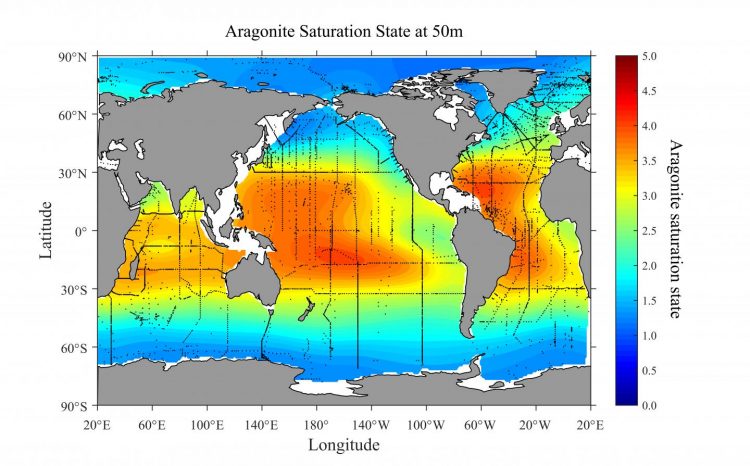New research maps areas most vulnerable to ocean acidification

This map shows the global distribution of aragonite saturation at 50 meters depth. The graphic shows areas that are most vulnerable to ocean acidification since they are regions where the saturation of aragonite is lower. Aragonite is a calcium carbonate mineral that shellfish use to build their shells. Credit: NOAA
“These findings will help us better understand and develop strategies to adapt to the severity of ocean acidification in different marine ecosystems around the world,” said Richard A. Feely, a NOAA oceanographer and co-author of the study, which has been accepted for publication and can be read online in the American Geophysical Union journal Global Biogeochemical Cycles.
Ocean acidification is caused by humankind's release of carbon dioxide emissions to the atmosphere. Excess carbon dioxide enters the ocean, reacts with water, decreases ocean pH and lowers carbonate ion concentrations, making waters more corrosive to marine species that need carbonate ions and dissolved calcium to build and maintain healthy shells and skeletons. The saturation state of seawater for a mineral such as aragonite is a measure of the potential for the mineral to form or to dissolve.
In the new study, scientists determined the saturation state of aragonite in order to map regions that are vulnerable to ocean acidification. Waters with higher aragonite saturation state tend to be better able to support shellfish, coral and other species that use this mineral to build and maintain their shells and other hard parts.
This study shows that aragonite saturation state in waters shallower than 328 feet or 100 meters depth decreased by an average of 0.4 percent per year from the decade spanning 1989-1998 to the decade spanning 1998-2010. “A decline in the saturation state of carbonate minerals, especially aragonite, is a good indicator of a rise in ocean acidification,” said Li-Qing Jiang, an oceanographer with NOAA's Cooperative Institute for Climate and Satellites at the University of Maryland and lead author.
The most vulnerable areas of the global ocean are being hit with a double whammy of sorts. In these areas, deep ocean waters that are naturally rich in carbon dioxide are upwelling and mixing with surface waters that are absorbing carbon dioxide from the atmosphere. The carbon dioxide from the atmosphere is coming primarily from human-caused fossil fuel emissions.
“When oyster larvae are born they must draw on the energy in their yolk to build their aragonite shells to protect themselves from predators and grow into healthy adults,” said Feely. In waters depleted of carbonate ions, young oysters must expend more energy to build their shell and may not survive. This has significant consequences for the seafood industry.”
###
To read the research in the American Geophysical Union journal Global Biogeochemical Cycles, “Climatological distribution of aragonite saturation in the global oceans,” please go online to: http://onlinelibrary.
For access to the data used in the study, please see the archive of NOAA National Centers for Environmental Information: http://data.
NOAA's mission is to understand and predict changes in the Earth's environment, from the depths of the ocean to the surface of the sun, and to conserve and manage our coastal and marine resources. Join us on Facebook, Twitter, Instagram and our other social media channels.
Media Contact
All latest news from the category: Earth Sciences
Earth Sciences (also referred to as Geosciences), which deals with basic issues surrounding our planet, plays a vital role in the area of energy and raw materials supply.
Earth Sciences comprises subjects such as geology, geography, geological informatics, paleontology, mineralogy, petrography, crystallography, geophysics, geodesy, glaciology, cartography, photogrammetry, meteorology and seismology, early-warning systems, earthquake research and polar research.
Newest articles

First-of-its-kind study uses remote sensing to monitor plastic debris in rivers and lakes
Remote sensing creates a cost-effective solution to monitoring plastic pollution. A first-of-its-kind study from researchers at the University of Minnesota Twin Cities shows how remote sensing can help monitor and…

Laser-based artificial neuron mimics nerve cell functions at lightning speed
With a processing speed a billion times faster than nature, chip-based laser neuron could help advance AI tasks such as pattern recognition and sequence prediction. Researchers have developed a laser-based…

Optimising the processing of plastic waste
Just one look in the yellow bin reveals a colourful jumble of different types of plastic. However, the purer and more uniform plastic waste is, the easier it is to…



